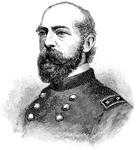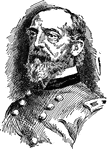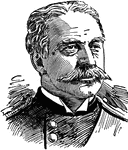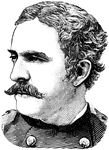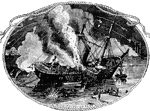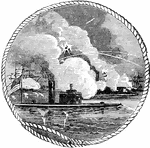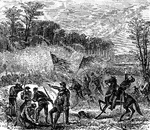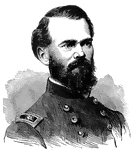
General James B. McPherson
"General McPherson, born in Sandusky, Ohio, November 14th, 1828, died near Atlanta, Ga., July 22nd,…

General George G. Meade
"General Meade, born in Cadiz, Spain, December 31st, 1815, died in Philadelphia, Pa., November 6th,…

Battle of Mechanicsville
The Battle of Beaver Dam Creek, also known as the Battle of Mechanicsville or Ellerson's Mill took place…

First Battle of Memphis
The First Battle of Memphis was a naval battle fought on the Mississippi River directly above the city…

Destruction of Merrimac
"Destruction of the Confederate ironclad steamer Merrimac, blown up by its commander, on the…
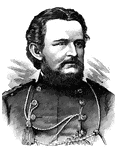
General Wesley Merritt
"General Merritt, born in New York city June 16th, 1836. He was graduated at the United States Military…

Discovery of a Confederate Battery at Messech's Point
The activity of the Confederates on the Potomac and the confluent rivers was almost incredible. In one…
Battle of Middletown
"Battle of Middletown, on the afternoon of the 19th of October, 1864. Great victory won by Major General…
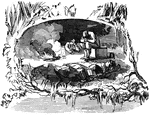
Midnight in the West
"Camp life in the West. During one of the pauses in the active part of the Missouri campaign our special…

General Nelson Miles
"General Miles, born in Westminster, Mass., August 8th, 1839. General Miles served in the Civil War."—…

Nelson A. Miles
(1839-1925) American soldier who sirved in the Civil War, Indian Wars, and the Spanish-American War.

Military authorities
"The military authorities at Washington, D. C., examining passes in 1861. This scene was of frequent…

Battle of Mill Spring
"Battle of Mill Spring, on the Cumberland River, near Jamestown, between a confederate force, 8,000…
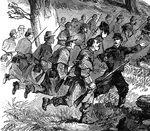
Battle of Mill Spring
"Battle of Mill Spring, on the Cumberland River, near Jamestown, between a confederate force, 8,000…
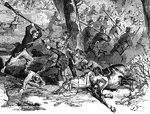
Battle of Mill Spring
"Battle of Mill Spring, on the Cumberland River, near Jamestown, between a confederate force, 8,000…

Battle of Mill Spring
"Battle of Mill Spring, on the Cumberland River, near Jamestown, between a confederate force, 8,000…

Gaine's Mill
Soldiers capturing a cannon. Depiction of the Battle of Gaine's Mill during the Civil War. It was the…

Millen Prison Pen
"The Prison Pen at Millen, Ga., as it appeared previous to the arrival of General Sherman's Army. Our…
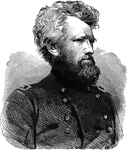
General Robert H. Milroy
"General Milroy, born in Washington County, Ind., June 11th, 1816, was graduated at Norwich University,…

War in Mississippi
"The war in Mississippi. General McPherson's army crossing the Big Black at messenger's Ferry, Thursday,…

War in Mississippi
"The war in Mississippi- defeat of Wirt Adams's Confederate cavalry by the Second Wisconsin cavalry,…
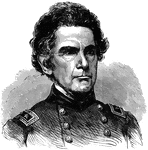
General Ormsby MacKnight Mitchel
"General Mitchel, born at Morganfield, Union County, Ky., August 28th, 1809, died at Hilton Head, S.…
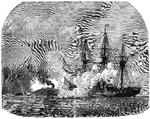
Mobile Harbor
"Farragut's naval victory in Mobile Harbor. The Hartford engaging the Confederate ram Tennessee.…
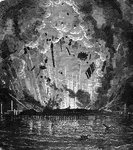
Siege of Mobile
"The siege of Mobile- explosion of Fort Powell, at Grant's Pass, July 5th, 1864."— Frank Leslie,…
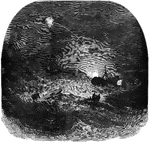
Monitor
"Loss of the Monitor- gallant attempt of the officers and crew of the United States steamer…
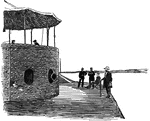
Monitor
Navy soldiers on the deck of the Monitor, a warship famous for the battle with the Merrimac.

General George W. Morgan
"General Morgan, born in Washington County, Pa., September 20th, 1820, died at Old Point Comfort, Va.,…
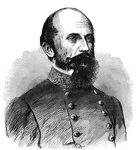
General John H. Morgan
"General Morgan, born in Huntsville, Ala., June 1st, 1826, died near Greeneville, Tenn., September 4th,…

Morning Detail
"The morning detail of the Fourth New Hampshire Volunteers going to work on the Hilton Head Fortifications.…
!["Morning mustering of the 'Contrabands' at Fortress Monroe, on their way to their day's work. As a living illustration of one of the aspects of the Civil War, a sketch is given above of the contrabands, [African Americans], going to their daily work at Fortress Monroe. The variety of the Ethiopian countenance is capitally given, and while some remind us of the merry phiz of George Christy in his sable mood, others wear the ponderous gravity of a New Jersey justice. The [African American] men had a comparatively pleasant time under their state of contraband existence."— Frank Leslie, 1896](https://etc.usf.edu/clipart/12400/12451/mustering_12451_mth.gif)
Morning Mustering
"Morning mustering of the 'Contrabands' at Fortress Monroe, on their way to their day's work. As a living…
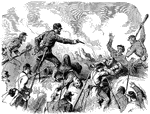
Lieutenant Colonel Morrison
"Heroic conduct of Lieutenant Colonel Morrison, Seventy-Ninth New York Highlanders, on the parapet of…

Mortar Battery Stanton
"Interior of the Mortar Battery Stanton, Tybee Island, Ga., showing the operation of 13-inch mortars…

Thirteen-inch Shell Mortar Practice
"Mortar practice- 13-inch shell mortar, as used by the Federal government- weight of mortar 17,000 pounds."…

Mortar Practice - Rear View
"Mortar practice- rear view of 13-inch mortar, with its usual complement of seven gunners. The mortar…
Fort Moultrie
"Siege of Charleston, S. C. Bombardment of Fort Moultrie and Batteries Bee and Beauregard by the monitors…

Battle of Munfordville
"Battle of Munfordville, Ky., Sunday, September 14th, 1862- the Confederates charging through the abatis…

Battle of Munfordville
"Battle of Munfordville, Ky., Sunday, September 14th, 1862- the Confederates charging through the abatis…

Battle of Munfordville
"Battle of Munfordville, Ky., Sunday, September 14th, 1862- the Confederates charging through the abatis…
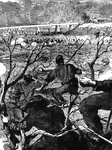
Battle of Munfordville
"Battle of Munfordville, Ky., Sunday, September 14th, 1862- the Confederates charging through the abatis…

Munson's Hill
"Skirmishing between the pickets of the two armies near Munson's Hill- the hill in the distance. Munson's…
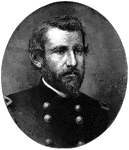
General Albert J. Myer
"General Myer, Chief Signal Officer, born in Newburgh, N. Y., September 20th, 1827; died in Buffalo,…

Destruction of Nashville
"Destruction of the famous Confederate privateer Nashville, in the Ogeechee River, Ga., by…

Naval Battle
"Naval action between the United States war steamer Mississippi and the Confederate iron-cased…

The Great Naval Battle on the Mississippi
First day's bombardment, Federal Schooners off Forts Jackson and St. Philip, commanding the passage…

Naval Practice
"Naval Practice Battery, navy yard, Washington, D. C. We present to our readers a sketch of what was…

Battle of New Bern
Landing at the Battle of New Bern, also known as the Battle of New Berne or Battle of Newbern which…

Battle of New Berne
"The battle of Newberne- final and successful charge of the Federal troops under General Burnside, on…

Battle of New Berne
"Battle of New Berne- Lieutenant Hammond capturing Colonel Avery, of South Carolina, while he was endeavoring…

New Fernandina
"Federal troops marching through Second Street, New Fernandina, Fla. Our sketch of New Fernandina in…
